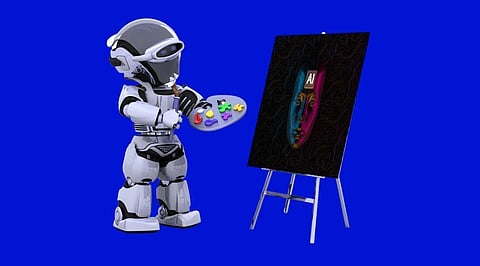

Photos of the same subject taken in a variety of poses might fill albums. Some appeared to be oil paintings, while others resembled anime sequences. My buddies changed appearance with each swipe, as if they had been recreated by a group of different painters. It turned out that this was sort of the truth. They had utilized the Lensa app, which charges users to post a number of selfies in exchange for an album filled with artificial intelligence (AI)-generated "avatars." What does this predicament signify for artists and the future of the creative industries as AI becomes more prominent in all spheres of life, not just the arts?
They have every right to be outraged, according to Walsh, when they learn apps using the work of artists like Leutwyler because "there is significant value being made here, and it's not being shared with the people whose art it was developed from." He concerns the viability of these programs as well as the sustainability of the artists. Many artists will stop creating art if AI-generated work denies them opportunity, money, and recognition. So that artists may continue to create art that will be used to train future systems, "we have to figure out ways to assure that the people whose work the systems depend do get some form of reward. At the moment, AI is controlled by humans, so Ewan McEoin, senior curator of contemporary art, design, and architecture at the National Gallery of Victoria, says that "in training AI generally there is a moral responsibility on the people who are doing the training to think about where they're directing this capability."
The latter triggered a red signal for artist and six-time Archibald Prize finalist Kim Leutwyler. They tell me from their Sydney studio, "I was really skeptical about where the source of all of this footage was coming from. They dug around and found "hundreds, if not thousands, of artists complaining that their work had been entirely ripped off — their precise color, composition, and style; these things that they've been working for years to achieve." It came out that one of them was Leutwyler. "I uploaded my own work and discovered that practically every painting, every portrait I've ever published on the internet was in there," said the user who was pointed to a website that allows users to search the databases used to train Lensa and other AI art-generating programs. They were not by themselves. I discovered well-known Australian artists including Blak Douglas, Vincent Namatjira, Yvette Coppersmith, Del Kathryn Barton, my friends, and others whose work is being used without their permission, knowledge, or payment.
Walsh brought up the concept of using AI to boost the possibilities of art and to expand what is achievable. "I believe that the best approach to picture artificial intelligence is as an enhancement of who we are. We've always utilized tools, and now there's one that will help a lot of us create much more beautiful work than we otherwise could. Since nearly the beginning, technology has been intrinsically interwoven to Anadol's art. He explains to me, "I've been programming computers to create art since I was 14 years old. He began using AI at Google as an artist in residence seven years ago. So we are a pioneer studio, he continues, "because seven years with AI is like 70 years." The broad and internationally exhibited work produced by Refik Anadol Studio employs technology to explore concepts in novel ways. For example, in the piece Melting Memories, Anadol makes use of EEG data to attempt to visualize the idea of memory.
It's challenging for protections to keep up with the rapid evolution of AI, which sparks discussions about how to both look at the creative potential of AI and preserve already-existing work. When McEoin stops to chat with me, he is biking to the gallery. The sound of birds chirping and a light wind provides the background music to our conversation. We must keep in mind that artificial intelligence (AI) is a tool, and that it wasn't created with the intention of producing art. It's a tool that can handle enormous amounts of data, she said.
It's difficult to say whether AI directly endangers artists because they might be easily replaced by robots that learn from everything that humans have produced before them.
Join our WhatsApp Channel to get the latest news, exclusives and videos on WhatsApp
_____________
Disclaimer: Analytics Insight does not provide financial advice or guidance. Also note that the cryptocurrencies mentioned/listed on the website could potentially be scams, i.e. designed to induce you to invest financial resources that may be lost forever and not be recoverable once investments are made. You are responsible for conducting your own research (DYOR) before making any investments. Read more here.
